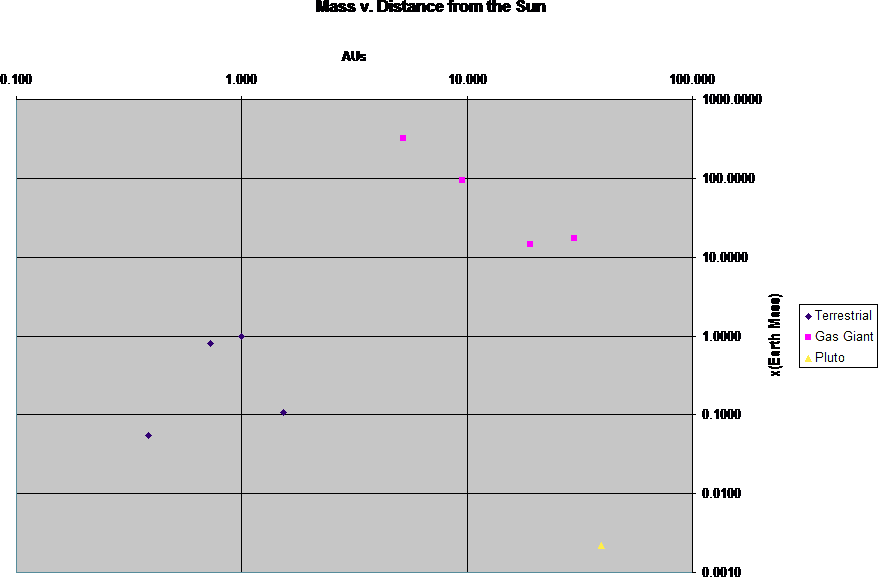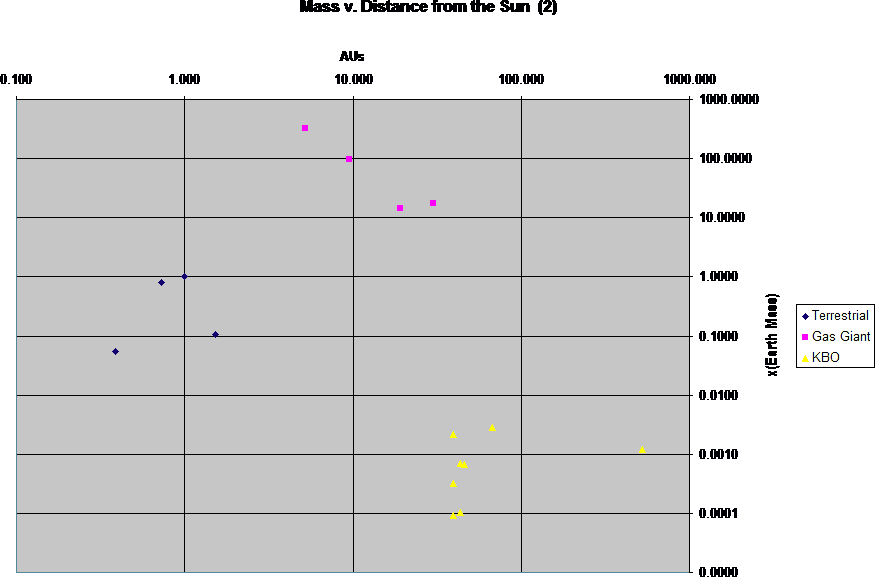

No, this isn’t the author’s attempt to try his take on the “Harry Potter” series. Rather, this is the first of three articles covering Dr. Alan Stern lecture on how the discovery of Pluto changed astronomers’ view of the Solar System. (The author has added some background material where necessary.) He gave this lecture on Friday, February 6 of this year.
Before 1930, the Solar System appeared to consist of two types of major worlds: the terrestrial planets (hold that thought, folks—I’ll get to it in the third article) and the gas giants. The terrestrial worlds (Mercury, Venus, Earth and Mars) are relatively small, having diameters ranging from 4,880 km (Mercury) to 12,760 km (Earth). Their compositions are mostly of metals and silicates, which tend to make them dense (from 3.9 to 5.5 times the density of water).
The gas giants (Jupiter, Saturn, Uranus and Neptune), on the other hand, are enormous; the smallest one (Neptune) is four times the size of Earth, while the largest (Jupiter) has a diameter about eleven times that of Earth’s. In spite of their enormous girths, three of these worlds have densities barely greater than that of water. The fourth (Saturn) could actually float if there were a cosmic-scale ocean in which to place it. The reason for the “lightness” of the gas giants is that their primary components are the gases hydrogen and helium (hence, the collective name).
Astronomers considered the Solar System to be “tidy” in that each planet was isolated from the other worlds by empty space. Additionally, the planets revolved around the Sun in the same direction in nearly circular orbits.
Recalling whatever mnemonic you used to remember the order of the planets from nearest-to-the-Sun outward, you can see that all the terrestrials are near the Sun while the gas giants inhabit the colder regions of the Solar System. Thus it became natural for scientists to divide the planetary region into two zones.
There were many known comets and asteroids as well, but the largest one (1 Ceres) has a diameter of ~950 km—only about a fifth that of Mercury’s. These weren’t really considered significant on the planetary scale, so they were regarded as “minor bodies.”
The two-zone model began its demise in 1930; that is when Clyde Tombaugh discovered Pluto. As further observations of this distant world accumulated, it became clear that Pluto was a “misfit.” (See Figure 1.) It was smaller than Mercury and larger than 1 Ceres, yet thermal observations confirmed that it was more like a comet than a terrestrial planet. If it was a comet, however, it was by far the largest one ever seen. (In 1978 James Christy added more fuel to the fire by discovering Charon, a moon of Pluto that has half the diameter of its primary. No comet was known to have any satellites at all. Two more Plutonian moons, Nix and Hydra, were discovered by the Hubble Space Telescope in 2005.)

Pluto’s orbit was also odd. For one thing, its eccentricity (how far from being circular it is) was greater than any of the other planets. Most of the planets have an eccentricity (e) value that is less than 0.100 (with e = 0.000 representing a perfect circle). Mercury’s eccentricity is above 0.200, but Pluto’s over 0.250. For further comparison, a parabola has e = 1.000.
The tilt of Pluto’s orbit with respect to the ecliptic (i. e., the plane of Earth’s orbit) is also greater than any of its larger brethren. Mercury, again, had the greatest value with an inclination of 7°. Pluto easily beats that out with an orbital tilt of more than 17°.
These orbital characteristics are more common with those of comets than planets, so could Pluto just be an enormous comet? Was Pluto just the first discovery of a new class of world? In 1936 Frederick C. Leonard went as far as to suggest that they might be more such objects beyond Pluto’s orbit. Or, maybe, this body was merely the proverbial exception that proved the rule.
Pluto’s status as a planetary oddity might have been considered as final if it were not for the work of astronomers Kenneth Edgeworth and Gerard Kuiper. In 1951 Kuiper published a paper describing the formation of the Solar System. (Edgeworth had published a similar paper a few years earlier, but relatively few people—Kuiper included—knew about it.) In this paper, Kuiper showed how the giant planets would tend to fling less-massive bodies (like comets) into orbits beyond that of Neptune. These comets would tend to remain in a thick disk located between Neptune’s orbit (30 AU from the Sun) and the Oort Cloud, a spherical region of about some 100 billion comets that has an inner “edge” that may be as close as 2000 AU from the Sun. (An astronomical unit, or AU, is the average Earth-Sun distance—about 150 million kilometers.) Julio Fernandez bolstered this argument in 1980 by predicting that a belt of comets and planetesimals (very small celestial bodies) in the outer Solar System was the source of short-period comets. Further more, in 1987 the team of Martin Duncan, Thomas Quinn and Scott Tremaine showed via numerical analysis that low-inclination, shortperiod comets must come from the region proposed by Edgeworth and Kuiper.
But did this “Kuiper Belt” or “Edgeworth-Kuiper Belt” actually exist? In 1992 David Jewitt and Jane Luu of the University of Hawaii discovered 1992QB1, an object located 40 AU from the Sun. Not only was this body have the proper distance for a Kuiper Belt Object (KBO), but the inclination of its orbit was only about two degrees from the ecliptic.
The discovery of more KBOs followed; four more were found in 1993 and an additional ten the year afterward. By 2009 over thirteen hundred KBOs had been discovered in less than one percent of the sky. This implies that there about four hundred and seventy thousand of these bodies residing in the Kuiper Belt with more than one hundred and forty thousand of them having diameters over 100 kilometers. So far, five KBOs appear to be at least 1,000 kilometers wide. The largest known KBO, Eris, is even larger than Pluto. Figure 2 shows the masses and distances of the larger known KBOs along with their sister worlds. As you can see, there is definitely a third region.

Sterns said that the Kuiper belt is the largest physical structure in the Solar System. This author infers from this statement that the Oort cloud, which is certainly larger than the Kuiper belt, must merely surround the planetary neighborhood instead of being one of its regions. This regarded separation of territories is most likely because the Oort cloud was not part of the nebula that collapsed into the proto-planetary disk that eventually became the Solar System. (Note: the author has not been able to confirm this, yet.)
The Kuiper belt does not appear be unique to our system; astronomers have found many other such structures associated with other stars, such as Fomalhaut in the constellation Piscis Austrinus. KBOs, therefore, should be considered bodies that regularly occur in planetary systems and vastly outnumber a system’s terrestrial and gas giant worlds.
So, who are the misfits now?
Note: Many thanks to John Causland for providing me with a DVD of Dr. Sterns’ lecture. I also used The Planetary Scientist’s Companion as a reference for all three articles.
The diagrams were created by Doug Warshow and are similar to graphs used by Dr Sterns in his lecture.
[ See also part 2, “Kuiper Belt Objects and the Re-Organization of the Solar System,” by Douglas Warshow, October, 2009 and part 3, “Pluto, KBOs and the Definition of “Planet”,” by Douglas Warshow, November, 2009 ]